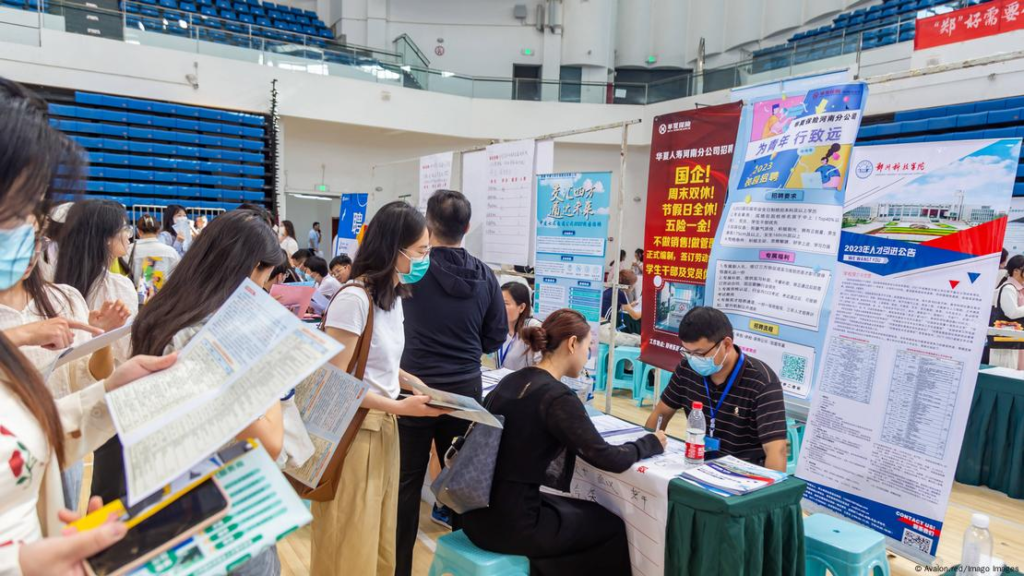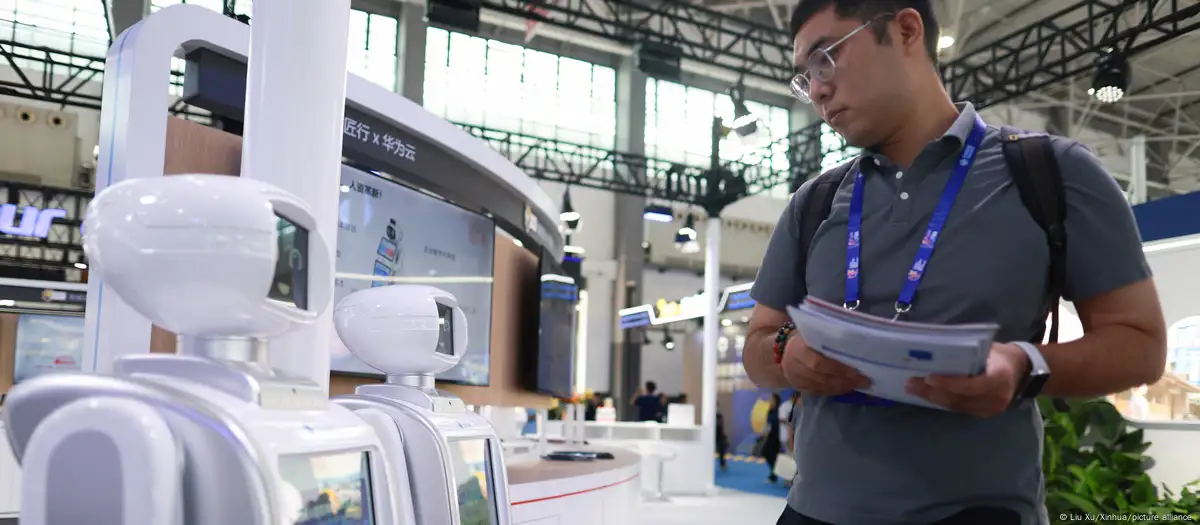China is investing billions to become a global tech power. But AI, robotics and quantum computing are not labor-intensive sectors, so what to do about the millions of young Chinese who can’t find a job?
When China’s youth unemployment rate reached a record high of 21.3% last year, Beijing did what authoritarian governments do whenever ugly truths emerge — it stopped publishing the data. After fiddling with its methodology for six months, China’s National Bureau of Statistics excluded students from the data and Bingo! — by December, youth joblessness had dropped by nearly a third.
Massaging the data, as many China watchers suspect happened, doesn’t make the problem go away. In July, after several months of small declines, the youth jobless figure rose sharply again — by a third to 17.1%.
Singapore-based Jiayu Li, senior associate at the public-policy advisory firm Global Counsel, told DW that even the previous data excluded millions of rural workers, who she said “face greater challenges in securing full-time employment,” than those in urban centers.
“The official figures don’t accurately capture the true situation on the ground. Even after questionable methodological revisions, the numbers are still rising, highlighting the gravity of the problem,” Li said.
While the Chinese economy may no longer be expanding at a double-digit annual rate, as it did in the early 2000s, the Asian titan is still projected to grow 5% this year, a figure most Western countries can only dream of. So, why can’t China create enough jobs for the roughly 12 million graduates and millions more school-leavers that enter the workforce each year?
So much for Xi’s promise of ‘common prosperity’
Blame structural issues, COVID-19, the sluggish post-pandemic recovery and trade tensions with the West. But just as crippling for economic growth, as well as the employment prospects of many young people, was the far-reaching crackdown by President Xi Jinping on the technology, real estate and private education sectors in 2020/21.
China’s tech giants, whose near monopoly was targeted by Xi’s reforms, lost more than a trillion dollars in market value. The property sector collapsed, taking the life savings of tens of millions of people along with it. China’s flourishing education-technology sector, which offered private tuition to an estimated 75 million students, was decimated. Mass layoffs inevitably followed and many of those affected were younger workers.
Online tuition platforms, for example, had grown in popularity for years, due to intense competition for university education among Chinese students and a cultural emphasis on high grades. In 2019, an estimated 10 million people were employed in China’s private tuition sector, many of them recent graduates.
“Xi’s crackdown sent a massive chill through this sector,” Diana Choyleva, chief economist at the London-based Enodo Economics, told DW. “Although tutoring jobs did not dry up completely, they became much more unstable and unreliable, reducing one avenue that underutilized graduates had used to mitigate their diminishing economic prospects.”
Young people shun blue-collar jobs
Another concern is the discrepancy between expectations and reality, as young people continue to shun blue-collar jobs to compete for high-paying white-collar positions.
Logic suggests that younger people would make up a large majority of the blue-collar workforce due to their fitness and agility. But Chinese media cited a 2023 study by Beijing’s Capital University of Economics and Business that found that about half of the country’s 400 million manual workers are above the age of 40.
“Vocational skills are often in high demand, but these pathways and jobs are seen as less desirable [by young workers],” Nicole Goldin, a non-resident senior fellow, at the Washington-based Atlantic Council think tank, told DW. While the Chinese government has introduced some incentives and reforms to the education system to address underlying structural issues, “it will take time to see any impact,” she added.
More chips than workers needed?
As China’s economy continues to rise up the value chain, Beijing has set its sights on global technological dominance. Huge investments in artificial intelligence (AI), chip production and green energy will help cut China’s reliance on the West. But these sectors don’t necessarily need a lot of new workers.
“The state’s focus is on emerging sectors like AI and electric vehicles, which are small and not labor-intensive, offering limited job creation,” said Global Counsel’s Li. “This stifles innovation and technological breakthrough — ironically the very thing Beijing wants to rely on to drive future growth.”
Li said the ongoing trade tensions with the West also put China’s export industry under strain as it has to “replace high-value orders from a de-risking West with lower-value ones from the Global South,” which has a knock-on effect on employment.
Hustle culture a hassle
Meanwhile, work in the gig economy, often facilitated by digital platforms for food delivery, ride-sharing or social-media influencing, has become oversaturated. Some 200 million Chinese make a living through these types of precarious roles, so many young people have given up trying to hustle.
“Wealthier youth may have opted for more education and many are choosing to ‘lie flat,'” said Goldin, referring to a growing social movement known in Mandarin as Tang Ping, where young people reject societal pressures to overachieve and seek a less materialistic life.
She also described how a growing number of young Chinese are becoming “professional children or grandchildren,” providing elder care for relatives — a function in growing demand due to an aging population and rising costs.

Chinese entrepreneurs are now risk-averse
By clamping down so heavily on the private sector, Xi has choked off investments in startups and the willingness of young entrepreneurs to take risks. The number of new Chinese startups has fallen by 97% over the past six years, the British business daily Financial Times reported this week — from over 51,000 in 2018 to some 1,200 last year.
Choyleva told DW that entrepreneurs and venture capital firms have become “extremely cautious” due to strict new regulations that have forced the private sector to align with Communist Party values, which she said was a “serious contradiction of the government’s agenda.”
“How can the private sector drive innovation while entrepreneurs are unwilling to take the risk to start a business? Long-term you lose out on companies that could have spurred massive employment for young people, and the multiplier effects they would have had for the country,” she said.
If China is on a path to potentially overtake the United States as the world’s largest economy, young talent must play a critical role in driving that growth, Goldin agreed.
“[High youth unemployment] undercuts productivity and will complicate China’s ability to compete globally. These young unemployed won’t be able to earn their way into the middle class, which will hurt consumption and have potentially destabilizing societal implications that would further hinder growth,” she warned.








